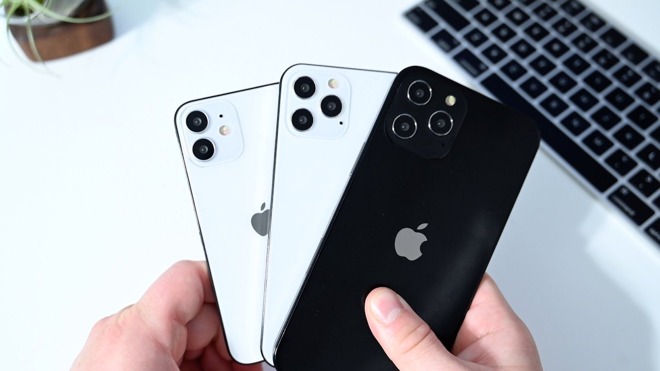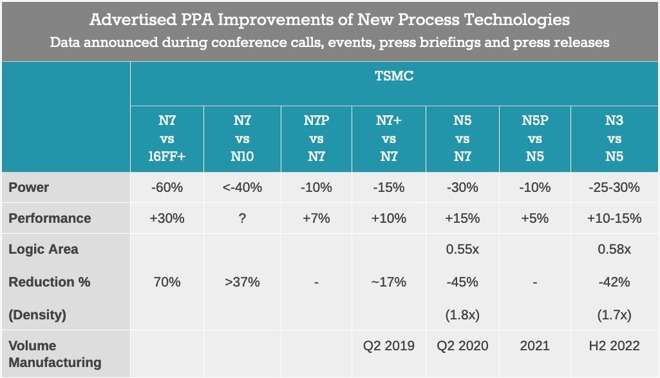TSMC reveals potential performance, power improvements in 'A14' chipset
Apple supplier TSMC has detailed some of the performance or power improvements from its new 5nm chip manufacturing process, expected to be used in the "iPhone 12."

Credit: Andrew O'Hara, AppleInsider
The A14 chipset is rumored to be the first major Apple Silicon to be based on TSMC's 5nm process node, which will bring either performance or power efficiency improvements to Apple's flagship iPhones.
At its annual Technology Symposium, TSMC has itself given numbers for how the new 5nm chips could improve on Apple's past silicon. AnandTech has provided a graph of the improvements, based on those numbers.

Credit: AnandTech
The current A13 chipset is based on TSMC's 7nm process node, represented by the N7 designation. The N5 category represents TSMC's 5nm process node, which is expected to be used in Apple's A14 chipset.
Compared to the N7 A13 chip, an Apple A14 chip could either be 15% faster at the same amount of power or 30% more power efficient. It may also be somewhere in the middle. Apple, for its part, has historically focused on power efficiency in its iPhone processors. But, what Apple does with these gains in Apple Silicon Macs is yet to be seen.
According to AnandTech, TSMC is also mass producing 5nm chipsets at its production facilities. Apple's next-generation System-on-Chip (SoC) -- the A14 processor -- is expected to be among the first candidates to be made using the new process.
TSMC also gave a future look at its 3nm chipmaking process, which could be either 25% to 30% more power efficient or 10% to 15% more performant than the 5nm process. The chipmaker's 3nm silicon are expected to enter production by the second half of 2022.
Of course, these numbers purely represent hardware gains. Apple can further optimize performance or power efficiency in iOS, or through hardware and software optimization.
Apple is expected to debut four iPhone models in 2020: 5.4-inch and 6.1-inch "iPhone 12" models, and 6.1-inch and 6.7-inch "iPhone 12 Pro" devices. All are expected to sport a new squared-off design, support for 5G, and other upgrades.

Credit: Andrew O'Hara, AppleInsider
The A14 chipset is rumored to be the first major Apple Silicon to be based on TSMC's 5nm process node, which will bring either performance or power efficiency improvements to Apple's flagship iPhones.
At its annual Technology Symposium, TSMC has itself given numbers for how the new 5nm chips could improve on Apple's past silicon. AnandTech has provided a graph of the improvements, based on those numbers.

Credit: AnandTech
The current A13 chipset is based on TSMC's 7nm process node, represented by the N7 designation. The N5 category represents TSMC's 5nm process node, which is expected to be used in Apple's A14 chipset.
Compared to the N7 A13 chip, an Apple A14 chip could either be 15% faster at the same amount of power or 30% more power efficient. It may also be somewhere in the middle. Apple, for its part, has historically focused on power efficiency in its iPhone processors. But, what Apple does with these gains in Apple Silicon Macs is yet to be seen.
According to AnandTech, TSMC is also mass producing 5nm chipsets at its production facilities. Apple's next-generation System-on-Chip (SoC) -- the A14 processor -- is expected to be among the first candidates to be made using the new process.
TSMC also gave a future look at its 3nm chipmaking process, which could be either 25% to 30% more power efficient or 10% to 15% more performant than the 5nm process. The chipmaker's 3nm silicon are expected to enter production by the second half of 2022.
Of course, these numbers purely represent hardware gains. Apple can further optimize performance or power efficiency in iOS, or through hardware and software optimization.
Apple is expected to debut four iPhone models in 2020: 5.4-inch and 6.1-inch "iPhone 12" models, and 6.1-inch and 6.7-inch "iPhone 12 Pro" devices. All are expected to sport a new squared-off design, support for 5G, and other upgrades.

Comments
Also curious how the rumors on A14 are basically nil? There's been more rumors for Mac chips than the A14 or A14X.
So, the 1.8x density improvement is just as huge, if not bigger, than the power consumption or performance rows. It's all related anyways.
So if we do N7P (A13) to N5 (assumed A14), then we have:
~22% power consumption decrease with the same performance
-OR-
~7.5% performance increase with the same power consumption
Not that it really matter, since I'm going to be ordering/preordering an iPhone 12 Pro Max when available, with the only unknown for me being the screen refresh rate; 60 Hz or 120 Hz.
It may come to pass that SVE2 will be a Mac only Apple Silicon due to power and chip size concerns, kind of mirroring Intel's AVX512 segmentation between Core and Xeon on Intel 14nm. That's all converging now with Ice Lake and follow-ons, but I can see Apple implementing SVE2 only for Mac silicon. And, scientific computing in a phone isn't something that is done regularly, unless there is some AR process that could use it.
The A13 has 8.5b transistors. An A14 could have 10b to 15b transistors. They could do a lot of things with an extra 2b to 6b transistors.
60 Hz display in iPhone 12 generation would be a bummer, with even $200 Android phones coming up with 90Hz displays (when they shouldn't be, with SoCs lacking enough power to drive the display. Not an issue for Apple's SoCs for last 3 years). And it wasn't Android OEMs who showcased the benefits of higher refresh rates to the world. It was Apple themselves implementing it in iPad pros more than 2 years ago, with Android OEMs choosing to follow Apple's direction in this aspect. Apple themselves not implementing it in iPhones even after 2 years is unacceptable. If quantity is the issue, then it would lead to questions on Tim Cook's mastery over the supply chain management.
I'm still hoping Apple will play around with some M-series blades that could be used in the Mac Pro or a configurable Mac maxi. Build some CPU blades, GPU blades, and combination blades on a nice backplane for compact servers and a supercomputer like the old days.
am I missing something?
This was not some last minute knee-jerk reaction by Razer to design their phone the moment the iPad was announced. It was very much a culmination of where the industry was headed and technology becoming available to the majority of OEMs. Even the Snapdragon 835 (used in the Razer Phone) was announced with features such as variable refresh rate (qsync) months before the iPad Pro was announced.
The benefits of high refresh rates and variable refresh rates have been known for a very long time prior to the iPad Pro.
Oh, and the Razer phone is a gaming phone, and isn't really comparable to Flagships in features, so not a good comparison.
Going back to what the other user had said, suggesting that Apple led the industry to adopt high refresh rate displays is false.
EDIT:
Here's the 120Hz Sharp display from mid-2016
How come when the iKnockoffs come out with a feature months or years after Apple it was "natural" or "already in production" but when Apple INVENTS something and it releases a month after Samsung crapped a turd on the market to beat Apple then "Apple COPIED!!"
Fu**ing stupid logic.